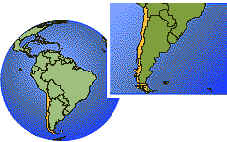
Chile

Chile, republic in southwestern South America, bounded on the north by Peru, on the east by Bolivia and Argentina, and on the south and west by the Pacific Ocean. It has an extreme northern-southern length of approximately 4270 km (about 2650 mi), but its average width is less than 180 km (less than 110 mi). Archipelagoes extend along the southern Chilean coast from Chiloé Island to Cape Horn, the southernmost point of the South American continent. Among these are the Chonos Archipelago, Wellington Island, and the western portion of Tierra del Fuego. Other islands belonging to Chile include the Juan Fernández Islands, Easter Island, and Sala y Gómez, all of which lie in the South Pacific. The country has a total area of 756,945 sq km (292,258 sq mi). Chile also claims a section of Antarctica. The country's capital and largest city is Santiago.

Land and Resources
The dominant physical feature of Chile is the Andes Mountains, which extend the entire length of the country, from the Bolivian plateau in the north to Tierra del Fuego in the south.
Physical Regions

Gigantic statues and other archaeological remains of an unknown origin are found on Easter Island, which lies west of the Chilean coast and is considered part of Chile.
Z. Roberts/ALLSTOCK, INC.
Chile can be divided longitudinally into three topographic zones: the lofty Andean cordillera on the east; the low coastal mountains on the west; and the plateau area, which includes the Central Valley, between these ranges. Latitudinally, three major geographical and climatological regions can be distinguished: the northern (arid), central (Mediterranean), and southern (temperate marine) regions.
The ranges of the Andes are widest in the northern region, forming broad plateaus and containing many mountains with elevations in excess of 6100 m (more than 20,000 ft). The country's highest peak, Ojos del Salado (6893 m/22,615 ft), is found on the border with Argentina. The plateau area is occupied by the great Atacama Desert, which contains vast nitrate fields and rich mineral deposits.
In the central region the plateau gives way to a valley, known as the Central Valley, about 1000 km (about 600 mi) long. The valley, which ranges from 40 to 80 km (25 to 50 mi) in width, is the most heavily populated area of the country. The fertile area between the Aconcagua and Biobío rivers forms the agricultural heartland of Chile. The central Andes are narrower in width and have lower elevations than those in the north. The most important passes in the Andes are located here. The country's finest natural harbors are located in this region.
The southern region is without an interior valley; it disappears below the sea at Puerto Montt. The long chains of islands along the coast are formed by the peaks of the submerged coastal mountains. The coastline here is indented by numerous fjords. The southern Andes have elevations that seldom exceed about 1800 m (about 6000 ft). Chile lies in a zone of geologic instability and is subject to earthquakes and volcanic activity.
Rivers and Lakes
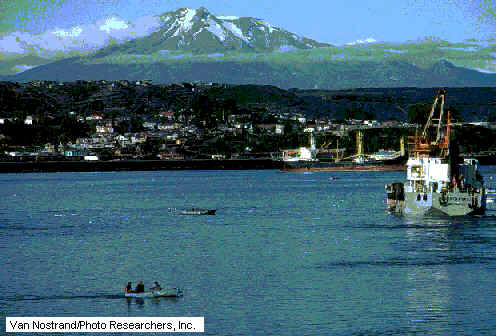
Puerto Montt, in the Los Lagos region of south central Chile, is one of the few good harbors in Chile. Most coastal cities rely at least in part on water transportation because of Chile’s difficult terrain.
Virginia Ferrero/DDB Stock Photography
The many rivers of Chile are relatively short, generally rising in the Andes and flowing west to the Pacific. In the northern and central regions the rivers are fed primarily by the perpetual snow cover of the Andes. The most important rivers (from north to south) are the Loa, Elqui, Aconcagua, Maipo, Maule, Biobío, and Imperial. Although of limited value for navigation because of cascades, the rivers are vital for the irrigation waters and hydroelectric power they furnish. Many of Chile's major lakes, including Lake Llanquihue, are concentrated in the scenic lake district of the southern region.
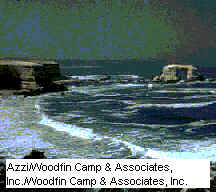
La Portada (Spanish for "the gateway") is a natural rock formation that resembles a gate or entrance, hence its name. It is located off the western coast of Chile, in the Antofagasta region.
Hi Pix
Climate
Because of its great latitudinal range, Chile has a diversity of climates. In general, temperatures are moderated by oceanic influences.
The northern region is almost entirely desert and is one of the driest areas in the world. Temperatures, however, are moderated by the offshore presence of the cold Peru, or Humboldt, Current. The average temperatures at Antofagasta range from 17° to 24° C (63° to 76° F) in January and from 11° to 17° C (51° to 63° F) in July. In Santiago the average range is 12° to 29° C (53° to 85° F) in January and 3° to 15° C (37° to 59° F) in July. Temperatures decrease about 1° C for each 150 m (about 1° F for each 275 ft) of altitude in the Andes. Rainfall increases southward, and the central region experiences a Mediterranean-like climate. Precipitation here is concentrated in the winter months (May to August) and ranges from an annual total of about 360 mm (about 14 in) at Santiago to about 14 mm (about 0.5 in) at Antofagasta. Winters here are mild, and summers are relatively cool. The southern region is cooler and experiences year-round rainfall. Precipitation reaches a maximum of about 5000 mm (about 200 in) near the Strait of Magellan, much of it in the form of snow. The average annual temperature at Punta Arenas in the far south is about 7° C (about 44° F). Strong winds and cyclonic storms are common in the southern region.
Vegetation and Animal Life
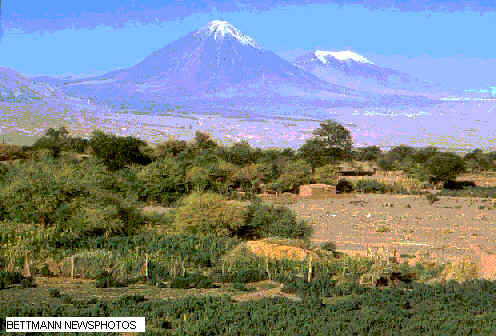
The Licancábur Volcano near San Pedro de Atacama is located in the Atacama Desert in northern Chile. Although the desert is one of the driest places in the world, it contains a few oases, such as the one pictured here, where small farming communities raise livestock and grow crops with the help of irrigation.
Hi Pix
The indigenous plant life of Chile varies according to climatic zone. The northern region has few varieties of vegetation (such as brambles and cacti) and is one of the earth's best examples of an absolute desert. The more humid Central Valley supports several species of cacti, espino (a thorny shrub), grasses, and the Chilean pine, which bears edible nuts. South of Valdivia are found dense rain forests containing laurel, magnolia, false beech, and various species of conifers. In the extreme south, a steppe vegetation of grasses is found.
Animal life is less diversified than in other parts of South America because of the barrier to migration presented by the Andes. Indigenous mammals include llama, alpaca, vicuña, guanaco, puma, Andean wolf, huemal (a large deer), pudu (a small deer), and the chinchilla. Birdlife is varied, but most of the larger South American types are absent. Aside from trout, which were introduced from North America, few freshwater fish inhabit Chilean streams and lakes. The coastal waters abound in fish and marine animals.
Mineral Resources
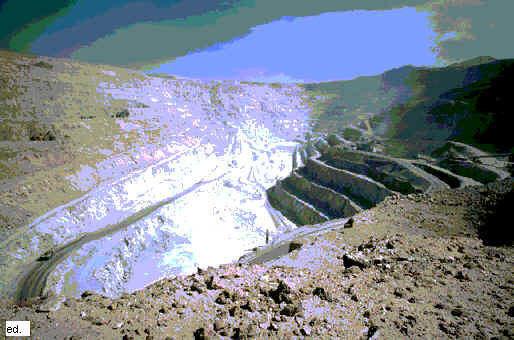
Chile is the world’s largest producer of copper, which plays a major role in the country’s economy. This mine is in the Atacama Desert of northern Chile.
Dan Budnik/Woodfin Camp and Associates, Inc.
Chile is rich in mineral resources, chiefly because of the size of the deposits rather than because of the diversity of minerals. Copper is by far the most important mineral. Others include nitrates, iron ore, coal, molybdenum, manganese, petroleum and natural gas, silver, and gold.
Population
Compared with other South American countries, Chile has a population that is relatively homogeneous. The early Spanish settlers intermarried with the Native Americans, notably the Araucanian; their descendants, the mestizos, constitute more than 92 percent of the current population. European immigration has not been as important in Chile as in other countries of the Americas; immigration was only mildly encouraged in the 19th century. German immigrants have, however, been an important influence in the Valdivia-Puerto Montt area. Italy, Austria, Switzerland, Great Britain, the former Yugoslavia, and France have also made significant contributions to the population. Today less than 2 percent of the country's population is of unmixed European stock. Only 6 percent of the population is pure Native American, mainly Araucanians who are concentrated in the southern region.
Population Characteristics
The population of Chile at the 1992 census was 13,321,803. The 1995 estimated population is 14,237,000, giving the country an overall population density of about 19 people per sq km (about 49 per sq mi). Some nine-tenths of the people live in the central region between Concepción and La Serena. The average annual rate of increase during the early 1990s was 1.5 percent. About 86 percent of the population lives in urban centers, and nearly one-third of the country's entire population lives in the capital city of Santiago. Communities both in the south and in the northern desert are generally isolated and separated by vast, virtually unpopulated stretches.
Principal Cities
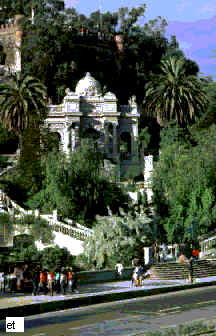
Cerro Santa Lucia is a prominent recreational area and public park in Santiago, the capital of Chile.
M. Oppersdorff/Photo Researchers, Inc.
The major cities of Chile are Santiago, the capital and largest city (population, 1992, 4,295,593); Concepción, an agricultural and industrial center (326,784); Viña del Mar, a popular resort (303,589); and Valparaíso, a principal seaport (274,228).
Language
Spanish is the official language of Chile and is spoken by virtually the entire population. The use of Native American languages is limited.
Religion
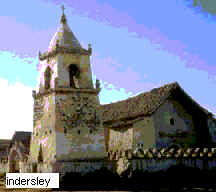
Spanish colonists brought the Roman Catholic faith to the Americas and established it as the region’s official religion during the 16th century. In present-day Chile, about four-fifths of the population follows Catholicism, although the country officially disestablished the church in 1925. Roman Catholic church leaders continue to actively promote social and political issues in Chile.
A. Wali
Roman Catholics constitute about 79 percent of the population of Chile. The Roman Catholic church is a major force in Chilean society, although the church was officially disestablished in 1925. Most of the remaining population is Pentecostal Protestant, and about 1 percent is Jewish. Native Americans practicing traditional religions constitute a very small minority.
Education and Cultural Activity
The arts and the educational system of Chile are, to a large extent, based on European models. Nevertheless, a distinctive cultural tradition has evolved that combines elements of the various ethnic groups and has been influenced by the expansion of the national frontier.
Education
Chile's modern education system had its origins in the mid-19th century. Today, eight years of education is free and compulsory for all children between the ages of 6 and 14. The school system is administered by the national government under the minister of education. The national literacy rate of about 93 percent is one of the highest in Latin America. Chile conducted intensive adult literacy campaigns in the 1980s and in the 1990s initiated programs designed for adult education.
In the early 1990s about 2,066,600 students were enrolled in primary schools each year and some 675,100 in secondary schools. A preschool program is also conducted. Among the institutions of higher education, the University of Chile (1738), a state-operated university in Santiago, is highly respected throughout the world. Other centers of higher learning include the University of Concepción (1919), the Catholic University of Chile (1888), the Catholic University of Valparaíso (1928), and several technical universities. Total annual enrollment in institutions of higher education in the early 1990s was nearly 285,400.
Cultural Life
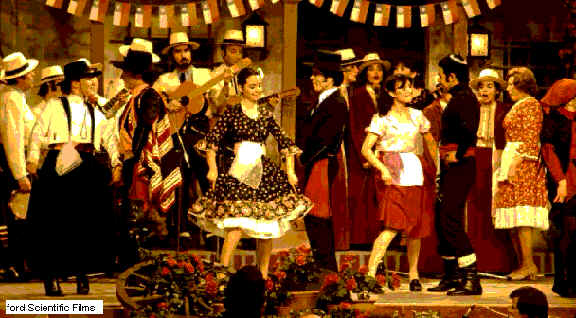
Chile has two prevailing cultures—the cosmopolitan culture of the affluent urban dwellers and the popular culture of the poorer, often rural communities. The latter culture generally manifests itself in folk expression, such as music and dance. Here a Chilean television show attempts to bridge that cultural divide by broadcasting Chilean folk dances.
C. J. Collins/Photo Researchers, Inc.
Two lively and contrasting cultural strains predominate in Chile: the cosmopolitan culture of the affluent urban population and the popular culture of the peasants, which is predominantly Spanish but contains traces of Araucanian heritage. The latter influences are strongest in Chilean music and dance. Chile has a flourishing literary tradition and has produced two Nobel Prize winners in literature, Gabriela Mistral and Pablo Neruda, both poets.
Cultural Institutions
Chile's most important cultural institutions are concentrated in the large cities of the central region. These institutions include the National Museum of Fine Arts, the National Historical Museum, and the National Museum of Natural History, all located in Santiago, and the Natural History Museum in Valparaíso. The country's largest library is the National Library in Santiago, with about 3.5 million volumes.
Government
The government of Chile was based on the constitution of 1925 until a coup d'état in 1973. Although it remained nominally in effect, most of the constitution's provisions guaranteeing popular democracy and due process were suspended. A new constitution was approved in 1980 and enacted in 1981 but its major provisions were not fully implemented until 1989.
Executive
The 1981 constitution vests executive power in a president, popularly elected for a four-year term, and a cabinet that is appointed by the president. Military leaders continued to control the government until 1989, when the first popular elections for president were held. In 1994 the legislature extended the presidential term to six years.
Legislature
In accordance with the 1981 constitution, Chilean voters in 1989 elected a bicameral legislature, called the National Congress. The Chamber of Deputies consists of 120 elected members, and the Senate comprises 46 elected members. All citizens age 18 and older are entitled to vote.
Judiciary
The highest judicial body in Chile is the Supreme Court, which has 17 judges. The country also has 17 courts of appeal. Judges are appointed for life by the president from a list submitted by the supreme court judges.
Local Government
For the purpose of local administration, Chile is divided into 13 regions (including Greater Santiago), which are subdivided into 51 provinces. The governors, who preside over the regions, and the officials who govern the provinces are appointed by the president. Provinces are further divided into municipalities.
Political Parties
All political activity was suspended after the 1973 coup and banned outright in 1977. Political parties were again legalized in 1987. In 1993 elections the center-left Concertación de los Partidos de la Democracia was victorious, winning 70 seats in the Chamber of Deputies. Other victorious parties included the Union Para al Progresso de Chile (47 seats), and several right-wing independents.
Social Services
Social welfare legislation was first enacted in the 1920s, and by the early 1970s the country's welfare program ranked as one of the most extensive in the world. After the 1973 coup, much of the welfare structure was cut back. Many people receive medical care under the auspices of the National Health Service. Workers may be insured to receive old-age pensions, unemployment benefits, disability expenses, and other benefits.
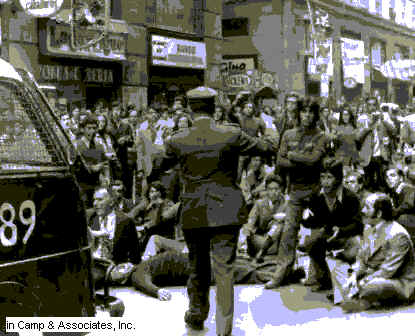
Labor demonstrators sprawl in the streets of Santiago, Chile in front of a patrol wagon during the third week of a labor strike that paralyzed the Chilean economy in the fall of 1972. Police in riot gear used tear gas to disperse demonstrators.
UPI/BETTMANN NEWSPHOTOS
Defense
Military service of one year in the army or two years in the navy or air force is compulsory in Chile for all able-bodied 18- or 19-year-old men. In the early 1990s the country's military force of 91,800 people was distributed as follows: 54,000 in the army, 25,000 in the navy, and 12,800 in the air force.
Economy
The Chilean economy has, since the early 20th century, been dominated by the production of copper. Since the 1940s the industrial sector has expanded rapidly, largely due to government efforts at diversification. Today Chile is one of the leading industrial nations in Latin America as well as one of its largest mineral producers. In the 1970s efforts were made to boost the output of the neglected agricultural sector and to reduce the country's dependence on imported food; after a slow-down in the production of major crops in the early 1980s, agricultural output improved later in the decade.
Since the leftist administration was deposed in 1973, the government has played a less dominant role in the economy, and most nationalized companies have been returned to private ownership. In the early 1990s the estimated national budget was balanced at $10.9 billion in revenues and $10.9 billion in expenditures. Chile's estimated gross domestic product (GDP) in 1994 was $52.2 billion.
By the 1990s Chile's economy was one of the strongest in South America, earning the country invitations to join the Asia-Pacific Economic Cooperation (APEC) forum and the North American Free Trade Agreement (NAFTA). Chile also became an associate member of MERCOSUR, or the Southern Cone Common Market, which also includes Argentina, Brazil, Paraguay, and Uruguay. Approval of Chile's NAFTA membership was held up in 1995 and 1996 by resistance in the U.S. Congress.
Agriculture
About 18 percent of the labor force of Chile is engaged in agriculture, forestry, and fishing, and this sector accounts for approximately 8 percent of the GDP. Except for sheep raising, conducted in the far south, the bulk of Chile's agricultural activity is concentrated in the Central Valley. Since the 1960s agrarian land-reform programs have been instrumental in increasing the number of small landowners, and modern farming methods have increased productivity. While only about 7 percent of Chile's land area is currently under cultivation, agricultural production doubled from the early 1980s to the mid-1990s. Chile exports more than twice the amount of agricultural products it imports.
While the share of land devoted to export crops such as fruit and vegetables is increasing, about half of all farms still raise wheat, the traditional foundation of Chilean agriculture. Leading crops in the early 1990s, ranked by estimated value and with annual production in metric tons, included grapes (1.1 million), apples (840,000), wheat (1.2 million tons), sugar beets (2.9 million), tomatoes (924,000), potatoes (926,000), and maize (899,000). Chile is the southern hemisphere's largest exporter of fruits, sending much of its crop to North America, where the fresh produce enjoys a market advantage due to the inverted growing season. The country also has an important wine-making industry. Sheep are raised in large numbers in the Tierra del Fuego and the Magallanes regions of Chilean Patagonia. As a whole the country had about 4.6 million head of sheep in the early 1990s. Annual wool output is about 18,500 metric tons. Other livestock include 3.6 million cattle, 1.3 million pigs, and 331,000 horses.
Forestry and Fishing
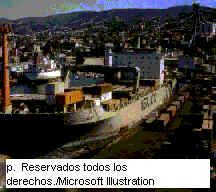
The capital of the Valparaíso region in central Chile, Valparaíso is one of the largest cities in Chile and one of its most important seaports. Here, a large shipping vessel waits at one of the docks in preparation for loading.
Robert Harding Picture Library
Forests cover about 21 percent of Chile's land area. Some 28.3 million cu m (about 999 million cu ft) of timber was cut annually in the early 1990s. Output consists of both hardwoods (such as laurel) and softwoods (such as pine). Lumber, pulp, and paper are made from the annual timber cut. Targeted for investment since the mid-1970s, the forestry industry accounted for more than 6 percent of annual exports by the early 1990s.
Chile has one of the largest fishing industries in South America. An annual catch of about 6.5 million metric tons is taken in the country's rich fishing waters. Principal species include mackerel, anchovy, sardine, and herring. Processing plants pack much of the fish catch for distribution.
Mining
Mining continues to play a critical role in Chile's economy, although the mineral component of exports is decreasing due to gains in other economic sectors. Chile has some of the world's largest known copper deposits and is the world's leading producer of this metal. Copper is the leading export, accounting for nearly 40 percent of all annual exports by value. About 2.0 million metric tons (metal content) were produced annually in the early 1990s. Petroleum and natural gas (first discovered in 1945) are extracted on Tierra del Fuego and in the Strait of Magellan. Some 6.5 million barrels of petroleum and 4 billion cu m (about 140 billion cu ft) of natural gas are produced annually. Iron ore, with an annual production of about 7.2 million metric tons, is the country's other leading mineral product. Chile also has large deposits of nitrates, iodine, sulfur, and coal, as well as silver, gold, manganese, and molybdenum.
Manufacturing
The manufacturing sector contributes about 18 percent of Chile's annual national output and employs about 17 percent of the labor force. Manufacturing is largely based on the refining and processing of the country's mineral, agricultural, and forestry resources. Chile is a major South American producer of steel, with an annual output in the early 1990s of some 336,700 metric tons of ingots. Copper is also refined, and the several oil refineries use both domestic and imported petroleum. Other important manufactures include food products, cement, pulp and paper products, textiles (cotton, wool, and synthetics), tobacco products, glass, chemicals, refined sugar, and electronic equipment. The assembly of automobiles is also important. The bulk of the country's manufacturing industry is located near Santiago and Valparaíso. Concepción is the other major industrial center.
Energy
The electricity-generating plants in Chile have a total capacity of about 5.8 million kilowatts and produced some 22 billion kilowatt-hours of electricity per year in the early 1990s. The fast-flowing rivers that descend from the Andes and the coastal ranges are potentially rich sources of hydroelectric power. Major efforts have been made to harness this potential, and by the early 1990s some one-quarter of Chile's energy was generated from waterpower.
Transportation
Chile has a network of about 79,600 km (about 49,500 mi) of roads, of which about 6343 km (about 3942 mi) are highways. In the mid-1990s Chile was seeking private investors to improve a 1600-km (about 1000-mi) section of the Pan-American Highway, and then to operate the section as a toll road. Railroad lines total about 8185 km (about 5086 mi) in length and are confined to the northern two-thirds of the country. The main northern-southern system is connected by spur lines to important coastal towns and by trans-Andean lines to points in Argentina and Bolivia. Because of the difficult terrain, many coastal cities rely on water transportation. Fine harbors are few, however. The principal ports are Valparaíso, Talcahuano and Tomé (both located on Concepción Bay), Antofagasta, San Antonio, and Punta Arenas. The most important international airports in the country are located near Santiago and Arica; others are at Antofagasta, Puerto Montt, and Punta Arenas.
Communications
Chile has a wide variety of modern communications media. In the early 1990s the country had 79 daily newspapers. El Mercurio, La Nación, and La Tercera de la Hora, all published in Santiago, have considerable influence. Television, introduced in 1958, is operated by a national government network and several independent stations. The country has more than 375 radio stations. Approximately 2.8 million television sets, 4.6 million radios, and 1.4 million telephones are in use throughout the country.
Currency and Banking
The monetary unit of Chile is the peso (407 pesos equal U.S.$1; 1996). The peso was introduced in 1975 to replace the escudo. The autonomous Central Bank of Chile (established in 1926) is the bank of issue and has broad powers to regulate monetary policy. Other banks include a state bank and a number of commercial and development banks.
Foreign Trade
In 1994 total annual exports were valued at $11.5 billion. Metals and mineral ores constituted nearly half of this total. Other important exports included fruits and vegetables, wood pulp and paper products, and chemicals. In 1994 imports were valued at $10.9 billion. The principal imports were machinery and transportation equipment, electric equipment, mineral products, and chemicals. Chile's chief trading partners for exports were Japan, the United States, Germany, Great Britain, Taiwan, Argentina, and Brazil. Principal sources for imports were the United States, Brazil, Italy, Argentina, and Germany.
Chile is a member of two international trade organizations including the Asia-Pacific Economic Cooperation (APEC), and the Latin American Integration Association (LAIA). Chile is also an associate member of Southern Cone Common Market (known by its Spanish acronym, MERCOSUR).
History
The first European to visit what is now Chile was the Portuguese explorer Ferdinand Magellan, who landed at Chiloé Island following his voyage, in 1520, through the strait that now bears his name. The region was then known to its native population as Tchili, a Native American word meaning "snow." At the same time of Magellan's visit, most of Chile south of the Rapel River was dominated by the Araucanians, a Native American tribe remarkable for its fighting ability. The tribes occupying the northern portions of Chile had been subjugated during the 15th century by the Incas of Peru. In 1535, after the Spanish under Francisco Pizarro had completed their conquest of Peru, Diego de Almagro, one of Pizarro's aides, led a gold-hunting expedition from that country overland into Chile. The expedition spent nearly three fruitless years in the country and then withdrew to Peru.
Spanish Settlement
Pedro de Valdivia, another of Pizarro's officers, led a second expedition into southern Chile in 1540. Despite fierce resistance from the Araucanians, Valdivia succeeded in establishing several settlements, including Santiago in 1541, Concepción in 1550, and Valdivia in 1552. In 1553, however, the Araucanians organized a successful uprising, killing Valdivia and many of his followers and devastating all the towns except Concepción and La Serena. The rebellion was the initial phase of warfare that lasted nearly 100 years. The Araucanians were the only important Native American people who did not quickly succumb to Spanish attack. Strife continued intermittently during and after the Spanish colonial period and did not end until late in the 19th century.
In the Spanish colonial organization Chile originally was a dependency of the viceroyalty of Peru and later had its own government. The country developed slowly, because it had neither important silver or gold deposits to attract the Spanish nor natives who were willing to labor. Moreover, it was far from the main centers of Spanish colonization in Peru and was difficult to reach. Farming in the Central Valley was the chief occupation, and Chile supplied Peru with foodstuffs, especially wheat. The townspeople lived by trade.
Independence from Spain
In 1810 Chile joined other Spanish colonies in breaking political ties with Spain. On September 18 of that year, celebrated thereafter as the Chilean independence day, the Santiago town council deposed the colonial governor of Chile, delegating his powers to a council of seven. Although this act marked the formal establishment of Chilean independence from Spain, intermittent warfare against Spanish troops, dispatched from Peru, continued for more than 15 years. A royalist army was decisively defeated at Chacabuco on February 12, 1817, ending Spanish control of northern Chile. One year later Bernardo O'Higgins, one of the revolutionary leaders, proclaimed the absolute independence of Chile. Nevertheless, royalist forces controlled nearly all of southern Chile until 1818, and were not completely expelled from the country until 1826.
Conservative Period
O'Higgins, who had been named director general of Chile in 1818, ruled the country with dictatorial powers until 1823, when popular hostility to his regime forced his resignation. A liberal constitution, establishing a republican form of government, was then adopted, but political strife among numerous organizations contending for power kept Chile in turmoil until 1830. In that year conservative elements, headed by General Joaquín Prieto, organized a successful rebellion and seized control of the government. In 1831 Prieto became president, but the leading person in the government was Diego Portales, who filled various cabinet posts during Prieto's administration. A new constitution, vesting immense powers in the executive department of the government, was adopted in 1833. Abortive armed attempts to remove the Conservatives from power were made by liberal groups in 1835, 1851, and 1859.
Despite its authoritarian character, the Conservative Party government fostered domestic policies that contributed substantially to the commercial and agricultural development of Chile. Steps were taken to exploit mineral resources, railroads were constructed, and immigration was encouraged. A school system and cultural institutions were established. The chief development in Chilean foreign relations during this period of Conservative dominance was a series of conflicts with neighboring countries—first with Bolivia and Peru in 1836, and then with Argentina, beginning in 1843. Armed hostilities were narrowly averted on several occasions in connection with this problem, which was not settled until 1881. In that year a treaty was signed, granting half of Tierra del Fuego to Chile.
Liberal Rule and Foreign Wars
Divisions resulting from disagreements with the Roman Catholic church had taken place, meanwhile, within the Conservative Party. Beginning in 1861 its liberal wing, in coalition with the Liberal Party, instituted a number of constitutional reforms, including prohibition of consecutive presidential terms. Endeavors to promote public welfare and the further development of national resources were intensified, notably by new railroad and highway projects and the creation of a postal system. In 1865 Chile became embroiled in a Spanish-Peruvian war that continued sporadically until 1869.
Chilean interests subsequently began the exploitation of the immensely valuable nitrate deposits in the Atacama Desert. Rejecting Bolivian claims to the region, the Chilean government in February 1879 ordered its military forces into the Bolivian port of Antofagasta. Two months later Peru, an ally of Bolivia, declared war on Chile, precipitating the War of the Pacific. As a result of its victory in this conflict, terminated in 1883, Chile acquired considerable territory, including the province of Antofagasta from Bolivia and the province of Tarapacá from Peru. Peru also yielded Tacna and Arica to Chile, on condition that after ten years a plebiscite be held. Although the two countries failed to agree on conditions for a plebiscite, disposition of the disputed areas was achieved in 1928 by negotiation, Tacna becoming a possession of Peru and Arica going to Chile. See Tacna-Arica Dispute.
Civil War and Natural Disaster
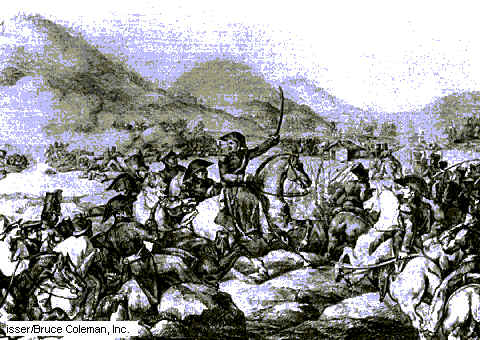
The Battle of Chacabuco in 1817 marked a decisive moment in the Chilean struggle for independence. Forces under the command of Chilean revolutionary Bernardo O’Higgins and Argentinian independence leader José de San Martín crossed the Andes Mountains from Argentina and defeated a loyalist army. The battle ended Spanish control of northern Chile and led to the liberation of Santiago, the capital of Chile.
CORBIS-BETTMANN
In 1891 political forces closely allied with the Roman Catholic clergy organized a revolt against the administration of President José Manuel Balmaceda, a Liberal Party leader. Under the leadership of naval officer Captain Jorge Montt, the rebels, who termed themselves Congressionalists, seized the Chilean fleet and the rich nitrate provinces in the north. In August they defeated a government army near Valparaíso. This city fell to the rebels, as did Santiago, virtually ending the war. More than 10,000 lives had been lost and considerable property destroyed. Balmaceda committed suicide in September. Shortly thereafter Montt became president, and Chile entered an extended period of peaceful reconstruction. As a concession to liberal sentiment in the country, Montt instituted several reforms, notably democratization of the executive department. The following years were marked by increasing participation of the Chilean people in politics and by mounting political turbulence.
In August 1906 a disastrous earthquake virtually destroyed Valparaíso and extensively damaged Santiago, killing more than 3000 people and leaving about 100,000 homeless. The damaged areas were rapidly rebuilt, however.
The World Wars
Chile was neutral in World War I (1914-1918). After the war, great strife developed in the country between liberal and conservative elements. The Liberals gained power with the election in 1920 of former minister of the interior Arturo Alessandri Palma, but he was unable to gain adoption of his proposals for reform. In 1924 a group of military figures accomplished a coup d'état, ostensibly for the purpose of forcing liberal reforms, driving Alessandri from office and establishing a military dictatorship. The dictatorship was overthrown early in 1925 in another military coup. A new constitution was written that reformed the electoral system, reduced the power of the congress, and established the separation of church and state. Alessandri was restored to the presidency, but his term lasted for less than a year. Under the next president, Emiliano Figueroa, governmental authority was actually wielded by an army officer, Carlos Ibáñez del Campo, who ruled as president from 1927 until 1931. Following additional coups and changes of administration, Alessandri was elected president again in 1932 and served until the end of his term in 1938.
In the election of 1938 a liberal government, with Radical Party member Pedro Aguirre Cerda as president, was elected by a coalition of democratic groups united in a popular front. His ambitious New Deal program was disrupted by a devastating earthquake that occurred in 1939, killing about 28,000 people. This coalition was successful again in 1942, when Radical Party member Juan Antonio Ríos was elected president, governing moderately amid the political tensions engendered by pro-U.S. and pro-Axis elements during World War II (1939-1945). Ríos led his country into a pro-Allies position, entering the war on the side of the United States in 1944. During the war the Communist Party emerged as one of the strongest political organizations in Chile. The country became a charter member of the United Nations in June 1945.
Postwar Governments (1946-1970)
The 1946 presidential election was won by Gabriel González Videla, the Radical Party leader who was supported by a left-wing coalition consisting mainly of the Radical and Communist parties. González Videla appointed three Communists to his cabinet, but the coalition endured for less than six months. The Communists, frequently at loggerheads with others of the government, were removed from the cabinet in April 1947. Later in the year diplomatic relations with the Union of Soviet Socialist Republics (USSR) were severed. In 1948 hundreds of Communists were incarcerated under the Law for the Defense of Democracy, which outlawed the Communist Party. A military revolt led by former President Ibáñez was suppressed. Manifestations of social and labor unrest were frequent during the following years; in 1951 strikes occurred in almost every sector of the economy.
A popular reaction against the traditional parties resulted in the election of General Ibáñez the following year. He restored some order but did not effectively cope with the economic and social problems. In 1958 Jorge Alessandri Rodríguez, a former senator and son of Arturo Alessandri Palma, heading a Conservative-Liberal coalition, was elected to the presidency on a platform favoring free enterprise and the encouragement of foreign investment. In response to strong opposition from the newly legalized Communist Party and the newly formed Christian Democratic Party, he proposed a ten-year plan that included tax reforms, building projects, and agrarian reform. He broke off diplomatic relations with Cuba in 1964 but resumed ties with the USSR. In 1960 a series of tsunamis (tidal waves) and earthquakes struck the country, causing widespread damage and killing thousands.
In the presidential election of 1964, former Senate member Eduardo Frei Montalva, candidate of the centrist Christian Democratic Party, defeated a leftist coalition. Frei's major reforms, such as partial government ownership of the copper industry, aroused dissatisfaction in both leftist and conservative elements that resulted in violent political opposition.
The Allende Regime
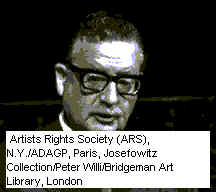
Educated as a physician, Salvador Allende served as president of Chile from 1970 until 1973, when military leaders overthrew his popularly-elected Marxist government. The leaders of the revolt claimed that Allende committed suicide after refusing to resign.
As the presidential election of 1970 approached, leftist opposition united to form a Popular Unity coalition; it nominated Salvador Allende Gossens, who waged his campaign on a platform that promised full nationalization of all basic industries, banks, and communications. He received about 37 percent of the votes, and Congress backed him overwhelmingly against his rightist opponent, former President Alessandri. Allende became the first president elected on a Marxist-Leninist program in a non-Communist country of the western hemisphere.
Once installed as president, Allende quickly began to implement his campaign promises, turning the country toward socialism. State control of the economy was instituted, mineral resources, foreign banks, and monopolistic enterprises nationalized, and land reform accelerated. In addition, Allende initiated a redistribution of income, raised wages, and controlled prices. Opposition to his program, however, was strong from the beginning, and by 1972 the result was seen in severe economic problems and a sharply polarized citizenry. The situation grew still more critical in 1973, when skyrocketing prices, food shortages (caused by the reduction of foreign credits), strikes, and political violence brought Chile to the brink of chaos. The crisis was aggravated by the United States, which worked to undermine the Allende regime. The climax came on September 11, 1973, when the military forces seized power; in the course of the coup d'état, President Allende committed suicide.
Pinochet Government
The military ruled through a junta headed by General Augusto Pinochet Ugarte. It immediately suspended the constitution, dissolved Congress, imposed strict censorship, and banned all political parties. In addition, it embarked on a campaign of terror against leftist elements in the country. Thousands were arrested; many were executed, tortured, or exiled, while still others languished in prison or simply disappeared.
For the next few years the junta retained its iron grip on the country, although some token relaxation could be seen toward the end of the decade. In 1976 Chilean opposition leader and former foreign minister Orlando Letelier and his U.S. secretary were killed by a car bomb while in Washington, D.C. At the time, the assassinations were widely believed to have been ordered by Chile's secret police. The state of siege was lifted in 1978 (although a state of emergency remained in effect), and more civilians were added to the cabinet. Chile, however, remained a police state. A new constitution, accepted by a referendum on the seventh anniversary of the military coup, legalized the regime until 1989, and Pinochet began another eight-year term as president in March 1981.
Economically, the Pinochet government, with its austere controls, slashed inflation and stimulated production between 1977 and 1981. Starting in 1982, however, the worldwide recession and declining copper prices led to a downturn in the Chilean economy. There were large-scale protests against the government in 1983, followed by a wave of bombings in major cities. Rising popular unrest and continued economic deterioration led Pinochet to reimpose a state of siege in November 1984. A treaty signed with Argentina later that month ratified Chile's claim to three islands in the Beagle Channel. After an unsuccessful attempt on Pinochet's life in September 1986, he launched new repressive measures.
Civilian Rule Restored
The state of emergency was finally lifted in August 1988, and in October Chileans were permitted to hold a plebiscite on whether Pinochet's term, due to expire in March 1989, should be extended to 1997. When nearly 55 percent of the electorate voted no, Pinochet's term was automatically extended to March 1990, pending free presidental and legislative elections. In December 1989, in Chile's first presidential election in 19 years, voters chose the Christian Democratic candidate, Patricio Aylwin. Also in 1990, Pinochet announced his intention to remain the commander-in-chief of the armed forces until 1997. Aylwin initiated modest economic reforms and appointed a commission to investigate human rights violations by the Pinochet regime.
In the 1993 elections Christian Democrat Eduardo Frei Ruiz-Tagle, son of Eduardo Frei Montalva, was elected president. In order to continue the country's movement toward civilian-controlled politics, President Frei proposed eliminating the nine senatorial positions filled by army appointees and asked for the institution of proportional representation in parliamentary elections.
In November 1993 the former head of Chile's secret police during the Pinochet government and his deputy were sentenced to seven- and six-year sentences for masterminding the 1976 Letelier assassination. The case, which was widely seen as a test of Chile's fragile democracy, was appealed and upheld by the Chilean Supreme Court in May 1995. While Chilean military leaders agreed to abide by the court's decision, the former police commander vowed to resist arrest and called on Pinochet to intervene. Pinochet denounced the decision and challenged the authority of the Supreme Court to sentence the men. After a tense standoff between the military and the civilian government, the two convicted men were arrested in June 1995.
In August 1995 Frei introduced legislation that would reopen and accelerate investigations into all 542 pending cases of people who "disappeared" during military rule. In November of that year compromise agreements were reached, which stated that cases would be reopened only if plaintiffs could submit new evidence; that cases already under military jurisdiction would remain so; and that judges would be allowed to close cases even if the victims' fate remained undetermined.